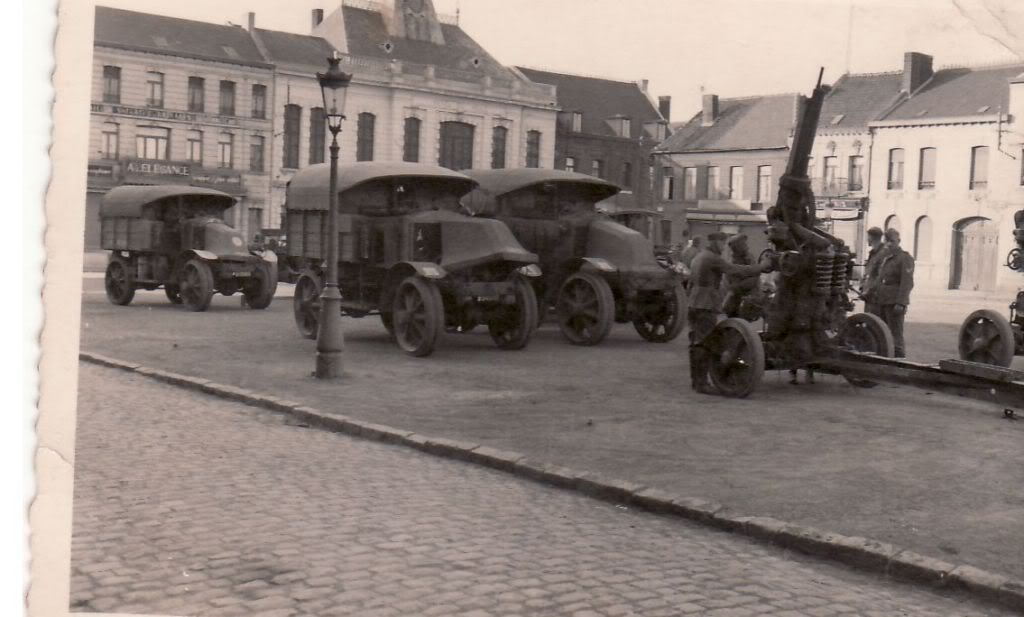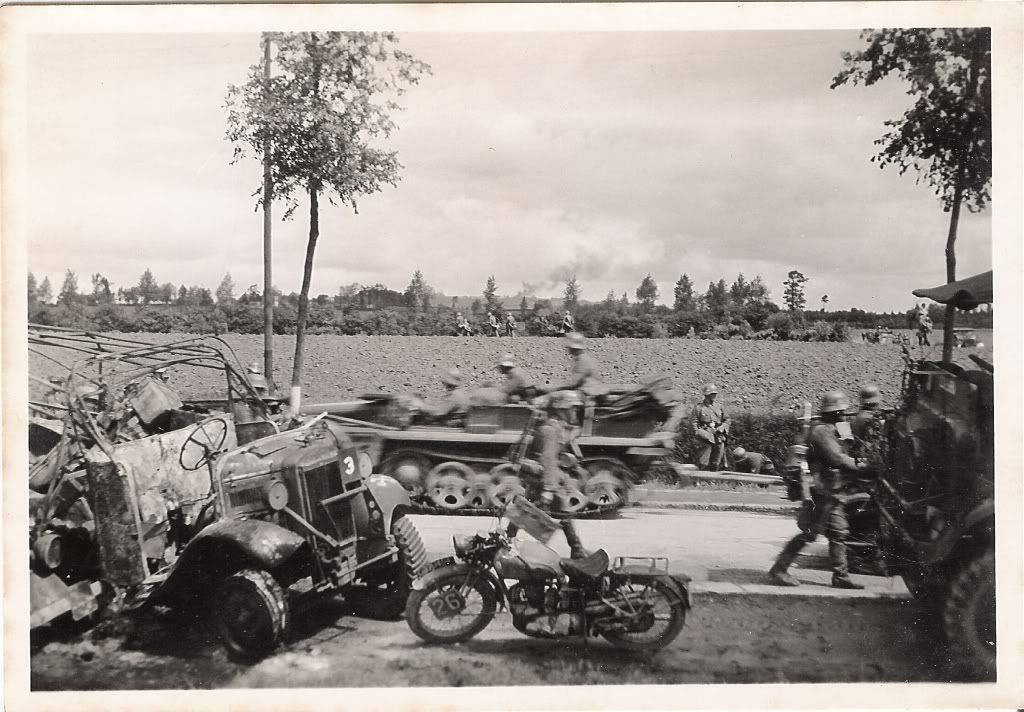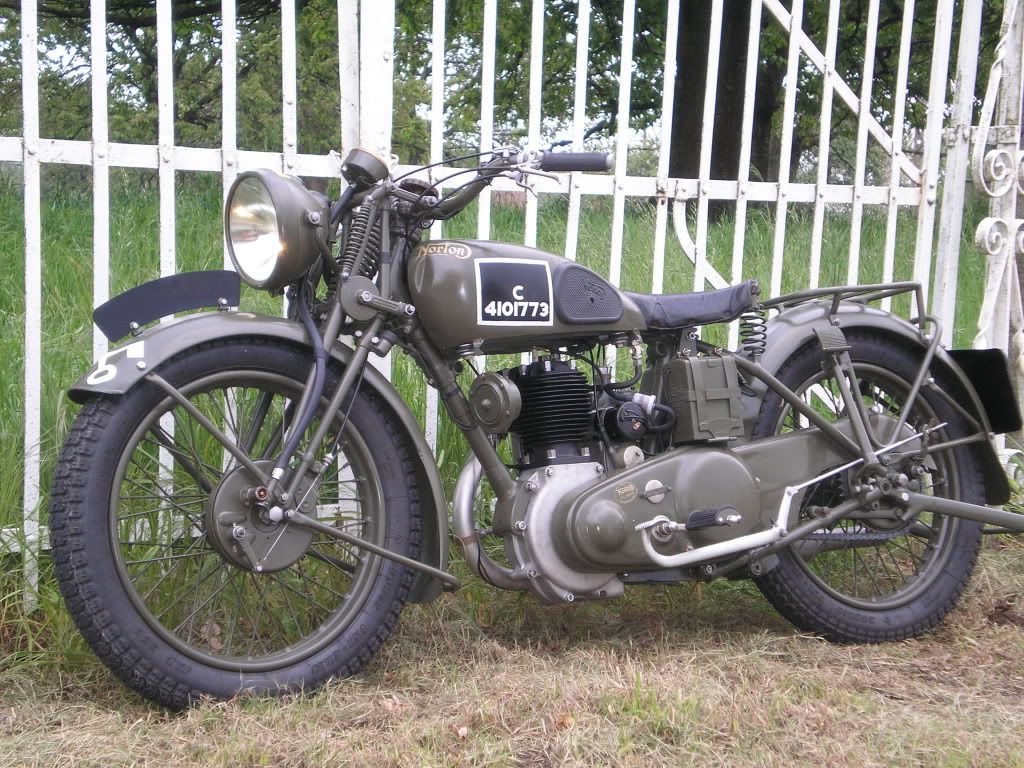-
Posts
1,024 -
Joined
-
Last visited
-
Days Won
6
Content Type
Profiles
Forums
Gallery
Blogs
Events
Articles
Store
Downloads
Posts posted by 79x100
-
-
Cracking pictures there Alan. The US Army did not have any wheeled heavy artillery tractors at the start of the war so borrowed a good number of Renaults (amongst others). The French were still using them at the start of WW2 hence the captured one.
Judging by the picture which was on ebay a while ago, they got hold of several at one go in this town :-

-
The bike was produced during early to mid 1941 under contract C7353. With it's manilla headlamp mask, number plate census number and lack of panniers, the photo probably doesn't date from later than 1942. The machine looks fairly well used so I'd guess that the picture dates from the summer of 1942. The background looks to be UK
I can't find any use of '844' during this period but the markings changed frequently and many are not recorded. The background appears to be a single colour and I don't think it's HQ black.
I wonder if the Arm of Service marking relates to troops serving at Command level in the UK. Do you know which battalion he was with ?
-
I saw the Luc Court at Beaulieu and thought 'What on earth is one of those ?' Little did I know that HMVF would provide the answer ! Beaulieu is a day of complete total sensory overload (and very dirty hands !)
By the way, I'm glad that this section is so active of late as the ordinary 'British Vehicles' one has become ever-so post war and the industrial archaeologist in me finds it difficult to become too excited about objects produced during my own lifetime.
-
It seems to me that dressing up and driving around in green vehicles or on noisy, oily old motorcycles is so obviously such a mature thing to be doing that we shouldn't expect the average youngster to be immediately ready for it. Isn't being old and daft something of a prerequisite ?
-
As a first attempt, it's worth dropping it in a pan of boiling water. That can swell the cork enough to help if it's not damaged. If not, the cork sheet can be bought. Watch out for cork with neoprene as it isn't fuel resistant but you can also find cork with viton which should do the job.
-
Wonderful ! I could almost smell it !
-
Is David Fletcher no longer there ? It is about a year since I spent a day in the archives but the chap who was helping us dragging out all sorts of dusty boxes was more than happy to 'just ask David'.
I'd say that if you can get there then it is well worth visiting the archive in person. The small office there was busy the whole time and they are aware of their limitations. There's no substitute for being there and building up some small rapport with the staff.
I'm not a 'Bovy apologist' but they were friendly and helpful despite my research being somewhat tangentiall to their focus.
-
Foot operated.
-
There's nothing new in this. Did anyone see the thread on 'pre-war' ?
http://hmvf.co.uk/forumvb/showthread.php?20350-Chinese-tank.
What is the correct word for this type of project ? It's not strictly speaking a replica, nor is it entirely a fake. 'Look alike' ? 'Snatch tribute' seems to sum it up best.
-
-
I noted the reference to Canadian usage of Loyds. This is something that arose on MLU a while back (I was only involved as there was a motorcycle in the photo). I've fixed the photo link there now.
Mark Tonner ID'd the charger carrier from the South Alberta Regiment
-
"You WHAT Atkins ?....You think you've left a casualty in the back of one ???"
-
The bike looks to be finished in SCC No.2 Brown which would be correct for the majority of British manufactured vehicles in use in NW Europe during 1944. Although the new British Olive Drab colour was being introduced during early 1944, instructions were that existing paint stocks were to be used up first and unless your bike had been through a rebuild, it would not have received the OD colour (and if you go down this route then you should, strictly speaking be thinking about a census number from the 'rebuild' sequences).
Regrettably, the display of Formation Signs on motorcycles was discontinued in accordance with Army Council instructions of October 1943. The only markings displayed thereafter were the Arm of Service insignia, usually on both sides of the fuel tank.
The Arm of Service marking for Divisional Signals in an infantry division at this point was a red '40' over the white / blue signals colours.
This scheme does not unfortunately give any indication of the division involved and perhaps therefore it is not uncommon to see restored bikes with the divisional Formation sign applied to the right hand side of the fuel tank although this is correctly a layout which was discontinued prior to June 1944.
-
I have a peculiar fascination for staring intently at early war signwritten census numbers and to me this one looks like L3931447 which would suggest that the vehicle relates to a 1939 contract.
The number is a possible as L3931200 - L3931476 were allocated to Leylands for contract V3532
Cat Ref 32 - Lorry 3 ton 6x4 GS
Cat Ref 33 - Lorry 3 ton 6x4 Small Box Girder
Cat Ref 34 - Lorry 3 ton 6x4 Machinery
Cat Ref 35 - Lorry 3 ton 6x4 Search Light
No indication in the Chilwell list of how the numbers were allocated within the contract but there is a good chance that the Contract Receipt card is held at Bovington and it may well have further information.
-
A different era I realise but the wiring diagrams for WD Nortons which had rubber sheathed cables according to a 1937 specification refer to 'cable colours' when in fact this was a small coloured rubber identifying band at each end. The harness itself was black rubber.
-
Are they the same as the motorcycle ones ? If so, this reply in the bike section might help :-
http://hmvf.co.uk/forumvb/showthread.php?10484-James-ML-Restoration/page4&highlight=rob+miller
-
Vanderveen in the old 'Fighting Vehicles Directory' notes "Trucks with over 15-cwt payload capacity were termed 'lorries'..."
Rob van Meel's reprint of the Chilwell RAOC lists has both 15cwt trucks and lorries listed (all with 'Z' census prefixes) plus of course the RASC 15cwt vans with a 'V' prefix. It is not clear how accurate a facsimile the lists are. A quick glance suggests that anything over 15cwt is indeed termed a lorry.
...None of which helps explain the Ford nomenclature. The possibility exists that they started with a system and lost track of the intentions as additional types were produced.
-
You would. A very nice buy. And if my eyes don't deceive me, that's a Crossley on the right.
I thought a Crossley IGL8 as well. The motorcycle is likely to be a Triumph 3SW unless it is a civilian impressed larger version.
-
Am I correctly identifying a CDF in this recent eBay acquisition ? It carries the 'crossed keys' of 2nd Infantry Division. The Arm of Service Insignia '3' should indicate 10th Field Regiment Royal Artillery but according to Hodges & Taylor should be on a red / blue horizontal background and I can see no colour change.

-
"Hey Pal, who is this Mademoiselle of Armytires anyway ?"
-
Stefano, Did you mean Terry Roberts at 'Metal Magic' / Heritage ? Terry Jones was the nude organist from Monty Python ! (He may well make Flea parts but I haven't heard of it !)
Terry Roberts is very good to deal with.
-
Here's a picture of it as it now stands, loosely assembled.
The lack of a tool box remains the most noticeable missing item. A WD Ariel box just went on ebay for £5. Why can't Norton stuff be that cheap and available? The ironic thing is that I passed over a later Norton toolbox at Netley Marsh two years ago because I thought it was too dear at £70. I'd jump at it now !
Looks like I'm going to be back over the water for Netley marsh and Beaulieu next month.
Rich.
Apparently I've been taking my time with this one. Perhaps I just like autojumbling and researching too much ? The plan was to have it ready for the 70th anniversary of the BEF retreat to the coast in 1940 but it's not really shaken down enough yet.
I shall at least try to get down to the Dyle Line before the end of the month.

It's leaning against a genuine period Belgian gate, although not the proper 'cointet' type. I shall have to look further afield for one of those.
-
Sorry to butt in on an existing thread but can anyone tell me where the MoS disposal site abbreviated as 'HAL' was ? Googling hasn't helped me and it doesn't ring a bell.
-
Glynn,
Rob Miller has had some made (or makes them). He appears regularly on the WM20 forum. It's worth a post there (no need to register)
http://pub37.bravenet.com/forum/static/show.php?usernum=3155626639&frmid=16&msgid=0
Be aware though that it's Stafford show weekend coming up so things are a bit quiet on the forum.



.thumb.jpg.8638c1c2349aab3213f0d167c381528f.jpg)

WW1 Renault EG (for sale but you probably wont be able to afford it)
in Pre WW2 vehicles
Posted
Another 1940 image on eBay at the moment.
What's the vehicle behind ?
Here's a better picture :-